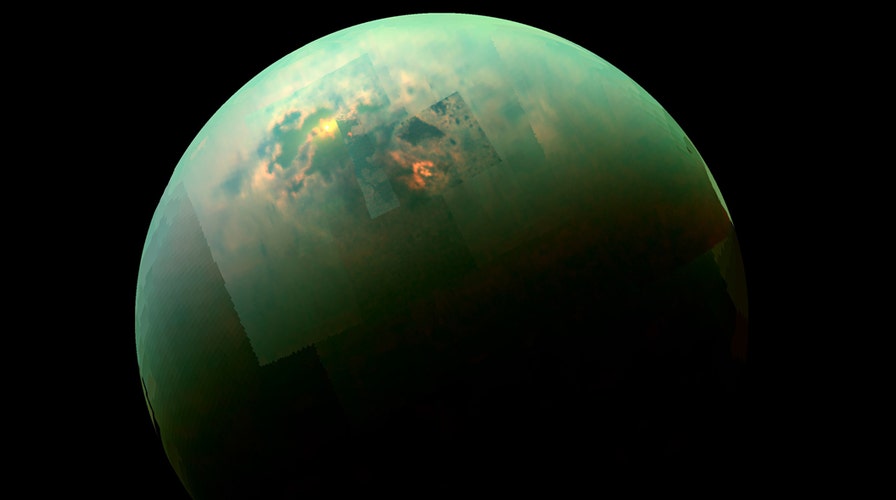Fox News Flash top headlines for April 23
Fox News Flash top headlines for April 23 are here. Check out what's clicking on Foxnews.com
Even the Night King would be jealous of a winter that lasts this long.
According to a new study, the polar vortex on Saturn's moon, Titan, can last "three-quarters of a Titan year, or about 22 Earth years."
The research, published in AGU’s journal Geophysical Research Letters, details the findings of NASA's Cassini spacecraft when it arrived at the Saturn system in 2004. The spacecraft, which intentionally plunged into Saturn's atmosphere in September 2017, found an enormous cap of cold air that sits over the poles in winter.
SATURN'S MOON TITAN HAS A LAKE WITH FEATURES SIMILAR TO EARTH, COULD SUPPORT LIFE
“Earth cools in winter due to lack of sunlight over the poles, but you don’t get this added effect from extra gases, whereas on Titan you’ve got these weird gases in there that’s making the process even more extreme than it would be otherwise,” the study's lead author, Nick Teanby, a planetary scientist at the University of Bristol, said in a statement.
"Spectra measured by Cassini's infrared spectrometer show that Titan's winter poles are much colder and significantly more enriched in trace gas species than more equatorial latitudes," the authors wrote in the study's plain language summary.
They continued: "These observations can be explained by the presence of winter polar vortices, where sinking air enriches the composition of the lower atmosphere and isolation by strong vortex winds allows enhanced cooling in the winter darkness. The coldest temperatures and most extreme trace gas concentrations were seen at Titan's southern pole during early winter and vortex formation."
One full year on Titan lasts 29.46 Earth years.

This near-infrared, color view from Cassini shows the sun glinting off of Titan's north polar seas. (Credit: NASA/JPL-Caltech/Univ. Arizona/Univ. Idaho)
Although Titan's atmosphere isn't exactly like Earth's — the presence of methane could be a factor in whether it's capable of supporting life — it does have other similarities, such as nitrogen.
"Why it's so interesting is that Titan is like a mini Earth with a really exotic and cold atmosphere that we can use to test climate models and things like that," Teanby continued. "That's the big picture to why we bothered, but I guess the real motivation is just that it's really cool to try and figure this stuff out."
Prospects of life?
Titan continues to be a source of fascination for researchers, with some even suggesting it could support life.
In January, researchers revealed that fresh rainfall had been spotted on Titan in 2016, which caused a reflective feature near the north pole of the moon.
In February 2018, NASA found traces of vinyl cyanide in the atmosphere and in September, dust storms were spotted on Titan for the first time ever, raising the prospect the storms could be a precursor to alien life on the celestial body.
It's possible the storms are comprised of "organic molecules" NASA said, due to the chemistry of the atmosphere. Titan's atmosphere is comprised of 98.4 percent nitrogen, 1.6 percent methane and 0.1-0.2 percent hydrogen.
SATURN'S BIGGEST MOON TITAN MAY BAKE ITS OWN ATMOSPHERE
However, once the organic molecules get big enough, they eventually fall to Titan's surface and may play a part in the dust storms.
The prevalence of dust storms and strong winds on Titan implies that the underlying sand can be moved as well and that the "giant dunes" that cover the moon's equatorial regions are constantly changing and still active.

